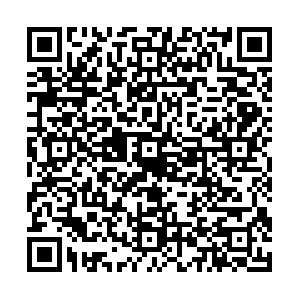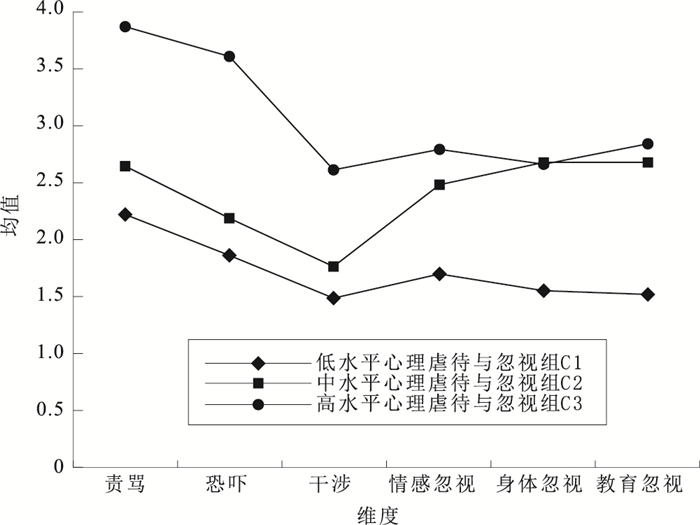Latent profile analysis on the association of psychological abuse and neglect with mobile phone dependence among adolescences
-
摘要:
目的 考察不同性别青少年心理虐待与忽视的潜在模式及其与手机依赖的关系,为青少年心理健康制定有效的预防和干预策略提供依据。 方法 采用整群随机抽样方法于2017年10月选取江西省赣州市2所中学和湖北省武汉市3所中学的1 070名初、高中学生为研究对象,采用儿童心理虐待与忽视量表(CPANS)、手机依赖指数量表(MPAI)和自编基本信息问卷对其进行横断面调查,采用潜在剖面分析构建不同性别群体心理虐待和忽视类型,并采用多元线性回归分析心理虐待和忽视与手机依赖的关系。 结果 男女生存在不同的心理虐待与忽视模式。男生分为低水平心理虐待与忽视组(56.68%,29.80%,13.52%)3组;女生分为低、中、高水平心理虐待与忽视组(49.38%,29.01%,11.12%)和高水平心理虐待组(10.49%)。遭受心理虐待与忽视的青少年更容易对手机产生过度依赖,男生对手机依赖表现为失控性[中水平:B值(95%CI)=0.28(0.12~0.44);高水平:B值(95%CI)=0.37(0.16~0.59),P值均<0.01]、戒断性[中水平:B值(95%CI)=0.29(0.11~0.46);高水平:B值(95%CI)=0.42(0.19~0.65),P值均<0.01]、逃避型[高水平:B值(95%CI)=0.33(0.07~0.59),P<0.05]和低效性[中水平:B值(95%CI)=0.35(0.16~0.53);高水平:B值(95%CI)=0.50(0.25~0.74),P值均<0.01],女生在高水平心理虐待中表现为逃避性和低效性[B值(95%CI)分别为0.34(0.01~0.67),0.46(0.14~0.78),P值均<0.05]。 结论 不同性别青少年心理虐待与忽视存在异质性差异,各潜在类别与手机依赖的关系不一致。 Abstract:Objective To identity patterns of psychological abuse and neglect among male and female adolescents, and to examine the relationship between psychological abuse and neglect with mobile phone dependence. Methods A total of 1 070 adolescents from 5 middle schools in Ganzhou and Wuhan were investigated with Child Psychological Abuse and Neglect Scale (CPANS), Mobile Phone Addiction Index Scale (MPAI) and demographic questionnaire. Latent profile analysis (LPA) was used to construct typologies of psychological abuse and neglect involvement in male and female adolescents. Results Three latent classes were identified for boys: low-level psychological abuse and neglect group (56.68%), medium-level psychological abuse and neglect group (29.80%), high-level psychological abuse and neglect group (13.52%). For girls, four latent classes were identified including low-level psychological abuse and neglect group (49.38%), medium-level psychological abuse and neglect group (29.01%), high-level psychological abuse and neglect group (11.12%); high-level psychological abuse group (10.49%). Adolescents who suffered from psychological abuse and neglect were more likely to be dependent on mobile phones. Among them, boys' dependence on mobile phones was manifested as out of control, withdrawal, escape and inefficiency[Medium level: B(95%CI)=0.28(0.12-0.44), 0.29(0.11-0.46), 0.35(0.16-0.53), high level: B(95%CI)=0.37(0.16-0.59), 0.42(0.19-0.65), 0.33(0.07-0.59), 0.50(0.25-0.74), P < 0.05], while girls showed evasion and inefficiency in high levels of psychological abuse[B(95%CI)=0.34(0.01-0.67), 0.46(0.14-0.78), P < 0.05]. Conclusion There are heterogeneous differences in psychological abuse and neglect between male and female adolescents, and the relationship between each category and mobile phone dependence varies. The results provide suggestions for adolescent mental health intervention. -
Key words:
- Torture /
- Mental health /
- Behavior, addictive /
- Regression analysis /
- Adolescent
1) 利益冲突声明 所有作者声明无利益冲突。 -
表 1 不同性别青少年心理虐待与忽视的潜在剖面分析拟合指数
Table 1. Fitting index of latent profile analysis of psychological abuse and neglect among gender-specific adolescents
性别 类别 AIC值 BIC值 nBIC值 Entropy值 PBLRT值 PLMR值 男
(n=584)2 7 608.72 7 691.75 7 631.43 0.82 < 0.01 < 0.01 3 7 389.58 7 503.19 7 420.65 0.80 < 0.01 < 0.01 4 7 216.95 7 361.15 7 256.39 0.79 0.32 0.09 5 7 118.36 7 293.15 7 166.17 0.83 0.24 0.07 6 7 048.00 7 253.38 7 104.17 0.81 0.23 0.80 女
(n=486)2 6 126.14 6 205.68 6 145.38 0.89 < 0.01 < 0.01 3 5 917.03 6 025.87 5 943.35 0.83 0.27 0.19 4 5 745.93 5 884.08 5 779.34 0.85 0.01 0.02 5 5 633.24 5 800.69 5 673.73 0.84 0.09 0.45 6 5 579.85 5 776.60 5 627.43 0.85 0.47 0.22 表 2 不同性别青少年心理虐待与忽视潜在类别和手机依赖及4个维度间多元线性回归分析(n=1 070)
Table 2. Regression analysis results of potential categories of psychological abuse and neglect and mobile phone dependence (including 4 dimensions)among gender-specific students(n=1 070)
性别 心理虐待与忽视 手机依赖 失控性 戒断性 逃避性 低效性 标准误 B值(B值95%CI) 标准误 B值(B值95%CI) 标准误 B值(B值95%CI) 标准误 B值(B值95%CI) 标准误 B值(B值95%CI) 男 中水平心理虐待与忽视 0.29 1.06(0.50~1.62)** 0.08 0.28(0.12~0.44)** 0.09 0.29(0.11~0.46)** 0.10 0.15(-0.04~0.35) 0.09 0.35(0.16~0.53)** 高水平心理虐待与忽视 0.38 1.62(0.87~2.37)** 0.11 0.37(0.16~0.59)** 0.12 0.42(0.19~0.65)** 0.13 0.33(0.07~0.59)* 0.13 0.50(0.25~0.74)** 女 中水平心理虐待与忽视 0.35 0.56(-0.12~1.24) 0.10 0.11(-0.08~0.30) 0.10 0.07(-0.13~0.27) 0.12 0.22(-0.01~0.45) 0.11 0.16(-0.07~0.38) 高水平心理虐待与忽视 0.49 0.51(-0.46~1.47) 0.14 -0.02(-0.28~0.25) 0.15 0.10(-0.19~0.39) 0.17 0.28(-0.05~0.60) 0.16 0.15(-0.17~0.46) 高水平心理虐待 0.50 1.08(0.09~2.07)* 0.14 0.24(-0.03~0.51) 0.15 0.04(-0.26~0.33) 0.17 0.34(0.01~0.67)* 0.16 0.46(0.14~0.78)** 注:*P<0.05,**P < 0.01。 -
[1] 邓云龙, 潘辰, 唐秋萍, 等. 儿童心理虐待与忽视量表的初步编制[J]. 中国行为医学科学, 2007, 16(2): 175-177. doi: 10.3760/cma.j.issn.1674-6554.2007.02.036DENG Y L, PAN C, TANG Q P, et al. Development of child psychological abuse and neglect scale[J]. Chin J Behav Med Sci, 2007, 16(2): 175-177. doi: 10.3760/cma.j.issn.1674-6554.2007.02.036 [2] STOLTENBORGH M, BAKERMANS-KRANENBURG M J, ALINK L R A, et al. The prevalence of child maltreatment across the globe: review of a series of Meta-analyses[J]. Child Abus Rev, 2014, 24(1): 37-50. doi: 10.1002/car.2353 [3] FANG X, FRY D, JI K, et al. Burden of child maltreatment in China: a systematic review[J]. Bull World Health Organ, 2015, 93(3): 176-185. doi: 10.2471/BLT.14.140970 [4] CHO S, BRAATEN C N. The role of age-specific trauma history and depression of caregivers in the intergenerational transmission of child abuse victimization: linear and quadratic latent growth curve models[J]. Child Youth Serv Rev, 2022, 135: 106390. doi: 10.1016/j.childyouth.2022.106390 [5] ZELVIENE P, DANIUNAITE I, HAFSTAD G S, et al. Patterns of abuse and effects on psychosocial functioning in Lithuanian adolescents: a Latent class analysis approach[J]. Child Abuse Negl, 2020, 108: 104684. doi: 10.1016/j.chiabu.2020.104684 [6] SHARRATT K, PANICKER A, BANERJEE R, et al. Profiles of abuse and neglect and the association with mental health indicators among a large sample of boys and girls from India[J]. Child Abuse Negl, 2021, 122: 105354. doi: 10.1016/j.chiabu.2021.105354 [7] HANG Y, LIAO H, GU J, et al. Anxiety and depression related to childhood maltreatment in teenagers: comparing multiple individual risk model, cumulative risk model and latent profile analysis[J]. Child Abuse Negl, 2022, 128: 105630. doi: 10.1016/j.chiabu.2022.105630 [8] VILLODAS M T, MORELLI N M, HONG K, et al. Differences in late adolescent psychopathology among youth with histories of co-occurring abuse and neglect experiences[J]. Child Abuse Negl, 2021, 120: 105189. doi: 10.1016/j.chiabu.2021.105189 [9] COHEN J R, THAKUR H. Developmental consequences of emotional abuse and neglect in vulnerable adolescents: a multi-informant, multi-wave study[J]. Child Abuse Negl, 2021, 111: 104811. doi: 10.1016/j.chiabu.2020.104811 [10] ALAZRI Z, HANNA K M. School personnel and child abuse and neglect reporting behavior: an integrative review[J]. Child Youth Serv Rev, 2020, 112: 104892. doi: 10.1016/j.childyouth.2020.104892 [11] KONG F, QIN J, HUANG B, et al. The effect of social anxiety on mobile phone dependence among Chinese adolescents: a moderated mediation model[J]. Child Youth Serv Rev, 2020, 108: 04517. https://www.sciencedirect.com/science/article/pii/S0190740919306784 [12] 徐华, 吴玄娜, 兰彦婷, 等. 大学生手机依赖量表的编制[J]. 中国临床心理学杂志, 2008, 16(1): 26-27. doi: 10.3969/j.issn.1005-3611.2008.01.009XU H, WU X N, LAN Y T, et al. Development of mobile phone dependence inventory for college students[J]. Chin J Clin Pshchol, 2008, 16(1): 26-27. doi: 10.3969/j.issn.1005-3611.2008.01.009 [13] ZHANG Y, DING Y, HUANG H, et al. Relationship between insecure attachment and mobile phone addiction: a Meta-analysis[J]. Addict Behav, 2022, 131: 107317. doi: 10.1016/j.addbeh.2022.107317 [14] SUN J, LIU Q, YU S. Child neglect, psychological abuse and smartphone addiction among Chinese adolescents: the roles of emotional intelligence and coping style[J]. Comput Hum Behav, 2019, 90: 74-83. doi: 10.1016/j.chb.2018.08.032 [15] LEUNG L. Linking psychological attributes to addiction and improper use of the mobile phone among adolescents in Hong Kong[J]. J Child Media, 2008, 2(2): 93-113. doi: 10.1080/17482790802078565 [16] 黄海, 牛露颖, 周春燕, 等. 手机依赖指数中文版在大学生中的信效度检验[J]. 中国临床心理学杂志, 2014, 22(5): 835-838. https://www.cnki.com.cn/Article/CJFDTOTAL-ZLCY201405016.htmHUANG H, NIU L Y, ZHOU C Y, et al. Reliability and validity of mobile phone addiction index for Chinese college students[J]. Chin J Clin Pshchol, 2014, 22(5): 835-838. https://www.cnki.com.cn/Article/CJFDTOTAL-ZLCY201405016.htm [17] NYLUND K L, ASPAROUHOV T, MUTHÉN B. Deciding on the number of classes in latent class analysis and growth mixture modeling: a monte carlo simulation study[J]. Struct Equ Model, 2007, 14(4): 535-569. doi: 10.1080/10705510701575396 [18] 周浩, 龙立荣. 共同方法偏差的统计检验与控制方法[J]. 心理科学进展, 2004, 12(6): 942-950. https://www.cnki.com.cn/Article/CJFDTOTAL-XLXD200406017.htmZHOU H, LONG L R. Statistical remedies for common method biases[J]. Adv Psychol Sci, 2004, 12(6): 942-950. https://www.cnki.com.cn/Article/CJFDTOTAL-XLXD200406017.htm [19] LACONI S, KALISZEWSKA-CZEREMSKA K, GNISCI A, et al. Cross-cultural study of problematic internet use in nine European countries[J]. Comput Hum Behav, 2018, 84(1): 430-440. https://www.sciencedirect.com/science/article/pii/S0747563218301250 [20] 谢国蝶, 韩阿珠, 陈俐如, 等. 童年期不良经历与青少年抑郁关系队列研究的Meta分析[J]. 中国学校卫生, 2019, 40(8): 1177-1181. doi: 10.16835/j.cnki.1000-9817.2019.08.016XIE G D, HAN A Z, CHEN L R, et al. Association between adverse childhood experiences and adolescent depression: a Meta-analysis[J]. Chin J Sch Health, 2019, 40(8): 1177-1181. doi: 10.16835/j.cnki.1000-9817.2019.08.016 -







 下载:
下载:


